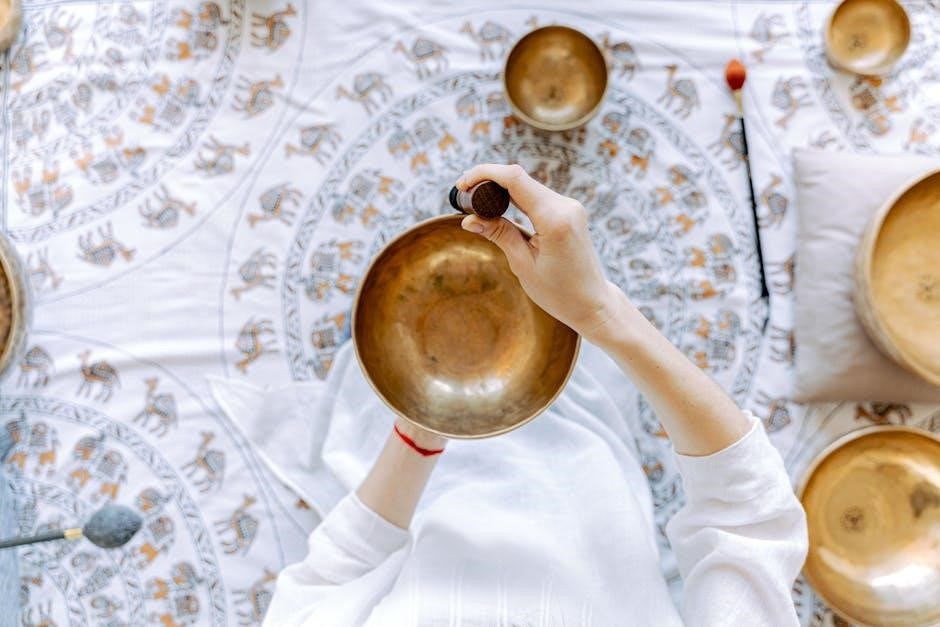The Five Tibetan Rites are an ancient practice of five exercises, over 2,500 years old, popularized by Peter Kelder․ They involve spinning, leg raises, kneeling backbends, tabletops, and the pendulum․ These rites aim to stimulate energy flow, enhance physical health, and promote spiritual well-being․ Originating from Tibetan Buddhism, they are believed to activate the chakras and improve vitality․ The practice is simple, requiring only 10-15 minutes daily, making it accessible for all fitness levels․ The “Five Tibetan Rites” PDF provides detailed guidance on performing these exercises correctly, ensuring their benefits are fully realized․
Overview of the Five Tibetan Rites
The Five Tibetan Rites are a series of five simple yet powerful exercises rooted in ancient Tibetan Buddhist traditions․ These rites, also known as the “Five Tibetan Rejuvenation Rites,” are believed to have originated over 2,500 years ago․ They consist of spinning, leg raises, kneeling backbends, tabletop poses, and pendulum movements, each designed to stimulate energy flow and balance the body’s chakras․ Practiced daily, these exercises aim to enhance vitality, flexibility, and overall well-being․ The rites are often performed 21 times each, though modifications are suggested for beginners․ Their holistic approach combines physical movement with spiritual intention, making them a unique practice for both body and mind․ This ancient system has gained popularity worldwide for its simplicity and profound benefits․
Historical Background and Origins
The Five Tibetan Rites, also known as the “Five Tibetan Rejuvenation Rites,” are an ancient practice believed to have originated over 2,500 years ago in Tibet․ Rooted in Tibetan Buddhism, these exercises were traditionally performed by monks in remote monasteries to maintain vitality, balance, and spiritual harmony․ The rites were passed down through generations, focusing on energy flow and chakra alignment․ Their modern popularity began with Peter Kelder, who first described them in his 1939 book, introducing the practice to the Western world․ The exercises are deeply connected to the concept of “rlung” (vital breath) and are said to promote longevity, flexibility, and spiritual growth․ This ancient system remains a cornerstone of holistic wellness practices today․
Purpose and Benefits of the Practice
The Five Tibetan Rites aim to enhance physical, mental, and spiritual well-being by stimulating energy flow through the chakras․ This practice is designed to rejuvenate the body, boosting vitality and flexibility while improving posture and balance․ It also supports emotional health by reducing stress and fostering a sense of calm․ The rites are believed to activate the body’s energy centers, promoting glandular health and organ function․ Regular practice may aid in weight management, improve circulation, and enhance overall longevity․ By aligning body and mind, the Five Tibetan Rites offer a holistic approach to health, making them a popular choice for those seeking a balanced lifestyle․ Their simplicity and effectiveness have made them timeless․

History and Development
The Five Tibetan Rites, an ancient practice over 2,500 years old, were introduced to the West by Peter Kelder in 1939, evolving into a global health system․
Origins of the Five Tibetan Rites
The Five Tibetan Rites, over 2,500 years old, trace their roots to Tibetan Buddhist monks who sought spiritual growth and vitality․ Their exact origin remains mysterious, but the rites are believed to have been practiced in Himalayan monasteries․ Peter Kelder popularized them in the West through his 1939 publication, highlighting their potential to balance the body’s energy and chakras․ The exercises aim to harmonize the flow of “rlung” (wind or breath), central to Tibetan spiritual practices․ Over time, the rites evolved into a global phenomenon, embraced for their simplicity and holistic benefits, blending physical movement with spiritual intent;
The Role of Peter Kelder in Popularizing the Rites
Peter Kelder played a pivotal role in introducing the Five Tibetan Rites to the Western world․ His 1939 book, “The Ancient Secret of the Fountain of Youth,” detailed the exercises, framing them as a path to vitality and longevity․ Kelder’s work not only popularized the rites but also adapted them for modern audiences, making them accessible beyond their traditional Tibetan context․ His teachings emphasized the connection between physical movement and spiritual energy, resonating with those seeking holistic health practices․ Through his writings, Kelder ensured the rites’ survival and widespread adoption, transforming them into a global phenomenon while preserving their ancient essence․
Evolution of the Practice Over Time
Over the centuries, the Five Tibetan Rites have evolved from a secretive monastic practice to a widely accessible routine․ Originally performed by Tibetan monks, the rites were initially passed down through oral tradition; Peter Kelder’s 1939 book brought them into the public eye, sparking global interest․ Modern adaptations have incorporated variations to suit different fitness levels, while retaining their core spiritual essence․ The rise of digital media has further popularized the practice, with instructional videos and guides like the “Five Tibetan Rites” PDF making it easier for individuals worldwide to adopt the routine․ This evolution ensures the rites remain relevant in contemporary wellness culture․

Physical and Spiritual Benefits
The Five Tibetan Rites enhance vitality, improve physical health, and foster spiritual balance․ They stimulate energy flow, aligning chakras to boost overall well-being and mental clarity effectively;
Physical Health Benefits of the Rites
The Five Tibetan Rites offer numerous physical health benefits, including improved flexibility, strength, and balance․ Regular practice can enhance posture, boost energy levels, and support weight management․ The exercises stimulate circulation, which may improve cardiovascular health and detoxify the body․ Additionally, they tone muscles, particularly in the core and limbs, contributing to overall physical resilience․ Many practitioners report reduced joint pain and improved mobility․ The rites are also known to enhance glandular function, potentially improving hormonal balance․ These exercises are low-impact, making them suitable for various fitness levels, and can be incorporated into daily routines for sustained physical well-being․
Spiritual and Emotional Well-Being
The Five Tibetan Rites are deeply rooted in spiritual practices, aiming to harmonize the body, mind, and spirit․ They are believed to balance the chakras, fostering emotional stability and inner peace․ Regular practice can reduce stress, enhance mental clarity, and promote a sense of calm․ The rites are also thought to cultivate compassion and self-awareness, aligning with Tibetan Buddhist principles․ By focusing on breath and movement, they help quiet the mind and connect practitioners to their inner selves․ This holistic approach not only rejuvenates the body but also nurtures emotional and spiritual well-being, offering a path to greater self-awareness and harmony in daily life․
Connection to Chakras and Energy Flow
The Five Tibetan Rites are deeply connected to the chakra system, believed to stimulate energy flow through the body’s seven main chakras․ Each rite is thought to activate specific chakras, enhancing the flow of “prana” or life force․ This energy flow is essential for balancing the body, mind, and spirit․ By aligning the chakras, the rites help prevent energy blockages, which are often linked to physical and emotional ailments․ The practice is rooted in Tibetan Buddhist principles, emphasizing the importance of harmonizing breath and movement to maintain vitality․ Regular performance of the rites is said to promote a balanced and vibrant energy flow, fostering overall well-being and spiritual harmony․

Each of the Five Tibetan Rites
The Five Tibetan Rites consist of five unique exercises: The Spin, The Leg Raises, The Kneeling Backbend, The Tabletop, and The Pendulum, each designed to enhance flexibility, strength, and energy flow․
Rite 1: The Spin
Rite 1, The Spin, involves spinning clockwise to stimulate the first chakra․ Stand erect, arms extended at shoulder height, and spin 21 times․ Inhale deeply while spinning, exhale as you stop․ This rite improves balance, coordination, and energizes the body․ It is believed to open the root chakra, enhancing vitality and grounding․ Begin slowly to avoid dizziness, gradually increasing spins․ Proper breathing is essential for maximum benefit․ This exercise is foundational, preparing the body for the subsequent rites․ Regular practice is said to boost energy flow and overall well-being, aligning with the Tibetan concept of “rlung” or life-force energy․
Rite 2: The Leg Raises
Rite 2, The Leg Raises, targets the second chakra, enhancing creativity and emotional balance․ Lie flat on your back, arms extended overhead, and raise your legs straight up 21 times․ Keep your knees slightly bent to protect the lower back․ This exercise strengthens abdominal muscles, improves flexibility, and stimulates energy flow․ Proper breathing is essential—inhale as you lift, exhale as you lower․ It is believed to energize the sacral chakra, promoting vitality and emotional well-being․ Regular practice is said to enhance creativity and reduce stress․ The “Five Tibetan Rites” PDF provides detailed instructions for mastering this rite effectively․
Rite 3: The Kneeling Backbend
Rite 3, The Kneeling Backbend, targets the third chakra, enhancing personal power and self-esteem․ Kneel with knees apart, toes together, and arms at your sides․ Inhale deeply, arch your back, and tilt your head backward, holding briefly․ Exhale as you return to the starting position․ This rite strengthens the spine, improves posture, and balances energy flow․ It is believed to open the solar plexus chakra, fostering confidence and clarity․ The “Five Tibetan Rites” PDF emphasizes proper alignment and controlled movements to avoid strain․ Regular practice is said to promote vitality, emotional resilience, and mental focus, aligning with the rite’s purpose of harmonizing body and spirit․
Rite 4: The Tabletop
Rite 4, The Tabletop, involves sitting with your legs straight, lifting your torso, and bending backward while supporting your body with your hands․ This rite strengthens the upper body, improves posture, and enhances flexibility․ It is believed to stimulate the fourth chakra, associated with the heart, promoting emotional balance and compassion․ Proper breathing is essential, with an exhale as you bend back․ The “Five Tibetan Rites” PDF provides detailed instructions to ensure safe and effective practice․ Regular performance of this rite is said to boost energy flow, improve circulation, and foster a sense of openness and connection to one’s emotions and surroundings․
Rite 5: The Pendulum
Rite 5: The Pendulum is a dynamic exercise where the body swings back and forth, resembling a pendulum․ It targets the sixth chakra, enhancing intuition and mental clarity․ Regular practice improves balance, focus, and spiritual awareness․ By stimulating energy flow, it contributes to overall vitality and well-being; The movement is believed to harmonize the body’s energy, fostering a deeper connection to one’s inner self, as outlined in the ‘Five Tibetan Rites’ PDF․

How to Perform the Rites
Proper breathing, posture, and alignment are crucial․ Start with 3-5 repetitions of each rite, gradually increasing to 21 as described in the “Five Tibetan Rites” PDF․
Proper Breathing Techniques
Proper breathing is essential for maximizing the benefits of the Five Tibetan Rites․ The “Five Tibetan Rites” PDF emphasizes deep, rhythmic breathing, synchronizing breath with each movement․ Inhale deeply through the nose, filling the lungs, and exhale fully through the mouth, ensuring energy flow is maintained․ During spinning, for example, deep inhales and exhales help balance the body and enhance the meditative state․ Consistent breathing prevents dizziness and ensures that the exercises are performed safely and effectively․ Proper technique, as outlined in the PDF, ensures that each rite is done correctly, promoting both physical and spiritual harmony․
Posture and Alignment
Proper posture and alignment are crucial when performing the Five Tibetan Rites to ensure safety and effectiveness․ The “Five Tibetan Rites” PDF provides clear guidance on maintaining correct form․ For example, during the spin (Rite 1), keeping the spine straight and arms extended helps balance energy flow․ In Rite 2 (Leg Raises), aligning the body symmetrically prevents strain․ The tabletop position (Rite 4) requires a straight line from head to heels to engage the core properly․ Correct posture ensures that each movement targets the intended muscles and chakras, enhancing both physical and spiritual benefits․ The PDF emphasizes the importance of awareness and precision to avoid injury and maximize results․
Recommended Number of Repetitions
The “Five Tibetan Rites” PDF recommends performing each of the five exercises 21 times daily for optimal results․ This practice, rooted in ancient tradition, is designed to energize the body and balance the chakras․ Start with fewer repetitions if necessary, gradually increasing to 21 as stamina improves․ Consistency is key, as the rites are believed to work cumulatively․ Over time, this daily routine can enhance vitality, flexibility, and overall well-being․ The PDF emphasizes that patience and dedication are essential to experience the full benefits of this timeless practice․

Chakras and Energy Flow
The Five Tibetan Rites stimulate full energy flow through the chakras, enlivening corresponding nerves, organs, and glands, promoting vitality and balance in the body and mind․
Understanding the Chakra System
The chakra system is an ancient concept rooted in Hindu and Buddhist traditions, describing seven energy centers along the spine․ These chakras govern physical, emotional, and spiritual well-being․ The Five Tibetan Rites are believed to activate and balance these energy points, fostering harmony and vitality․ By stimulating the chakras, the rites enhance the flow of “prana” (life force), which is essential for overall health․ Each rite targets specific chakras, ensuring a balanced energy flow that promotes mental clarity, emotional stability, and physical strength․ This ancient practice offers a holistic approach to wellness by aligning and energizing the body’s subtle energy system․
How the Rites Stimulate Chakras
The Five Tibetan Rites stimulate the chakras by activating the body’s energy centers through specific movements․ Each rite targets different chakras, enhancing their vitality and balance․ The spinning motion in Rite 1 energizes the root chakra, while Rite 2’s leg raises nourish the sacral chakra․ Rite 3, the kneeling backbend, opens the solar plexus, and Rite 4, the tabletop, strengthens the heart chakra․ Rite 5, the pendulum, aligns the throat and third-eye chakras․ By harmonizing these energy centers, the rites improve overall well-being, fostering physical health, emotional clarity, and spiritual awareness․ This practice ensures a balanced flow of energy, vital for holistic wellness and inner harmony․
Energy Flow and Its Importance
Energy flow is vital for maintaining physical, mental, and spiritual balance․ The Five Tibetan Rites are designed to enhance this flow by clearing energy blockages and harmonizing the body’s life force․ Proper energy circulation nourishes organs, glands, and nerves, promoting vitality and overall health․ When energy flows freely, it supports immune function, mental clarity, and emotional stability․ Blocked energy, however, can lead to illness and stagnation․ By practicing the rites, individuals can restore and balance their energy, fostering a state of holistic well-being․ Regular practice ensures optimal energy flow, which is essential for preventing disease, enhancing longevity, and achieving spiritual harmony․ This makes energy flow a cornerstone of the rites’ benefits․

Safety and Precautions
Consult a healthcare professional before starting the Five Tibetan Rites, especially if you have injuries or health conditions․ Proper breathing and technique are crucial to avoid injuries․ Begin slowly and gradually increase repetitions․ Avoid overexertion, as the rites are not a quick fix but a long-term practice․ Ensure proper posture and alignment to prevent strain․ Modifications are available for different fitness levels․ Be mindful of your body’s limits and stop if discomfort arises․ Consistency is key, but patience is necessary for noticeable benefits․ These rites are not a substitute for medical treatment or professional advice․
Contraindications and Safety Measures
The Five Tibetan Rites may not be suitable for everyone․ Individuals with spinal injuries, severe joint problems, or chronic health conditions should consult a healthcare professional before starting․ Pregnant women, those with high blood pressure, or recent surgeries should exercise caution․ Proper technique is essential to avoid injury; improper execution can strain muscles or joints․ Start slowly, especially if new to the practice, and gradually increase repetitions․ Avoid overexertion, as the rites are meant to be a gentle, consistent routine․ Always prioritize posture and alignment to minimize risk․ While the rites are beneficial, they are not a substitute for medical treatment or professional guidance․
Modifications for Different Fitness Levels
The Five Tibetan Rites can be adapted to suit various fitness levels․ Beginners may start with fewer repetitions, gradually increasing as strength and flexibility improve․ For those with physical limitations, movements can be modified, such as performing spins in a seated position or reducing the depth of leg raises․ Supportive props like chairs or walls can assist with balance and alignment․ Advanced practitioners can enhance intensity by adding dynamic breathing or increasing the number of repetitions․ The rites are versatile, allowing individuals to tailor the practice to their needs while maintaining the core benefits․ Consistency and mindful progression are key to reaping the rewards safely and effectively․
Common Mistakes to Avoid
When practicing the Five Tibetan Rites, several common mistakes should be avoided to ensure safety and effectiveness․ Overexertion is a frequent error, as rushing through the exercises can lead to injury․ Proper breathing techniques are essential; neglecting to synchronize breath with movement can reduce benefits and cause strain․ Improper posture is another mistake, as misalignment can hinder energy flow and lead to discomfort․ Additionally, bouncing or jerking movements should be avoided, as they can disrupt the body’s balance․ It’s crucial to perform each rite smoothly and mindfully, respecting the body’s limits; Guidance from experienced practitioners or resources like the “Five Tibetan Rites” PDF can help avoid these pitfalls and promote a safe, beneficial practice․

Comparisons with Other Practices
The Five Tibetan Rites share similarities with yoga and Tai Chi in promoting energy flow but differ in their structure and focus on chakra activation․
Similarities with Yoga
The Five Tibetan Rites share similarities with yoga in their focus on postures, breathing, and energy flow․ Both practices aim to balance the body’s energy and enhance well-being․ Like yoga, the rites involve physical movements that stimulate the chakras, promoting spiritual and physical harmony․ The emphasis on alignment, breath, and mindful execution is common to both traditions․ However, the rites are more concise, consisting of just five exercises, whereas yoga often includes a wider variety of poses and techniques․ Despite these differences, both practices are rooted in ancient Eastern philosophies and seek to unify the body, mind, and spirit for optimal health․
Comparison to Tai Chi and Qigong
The Five Tibetan Rites share similarities with Tai Chi and Qigong in their emphasis on energy flow and holistic well-being․ Like Tai Chi, they involve flowing movements that harmonize the body and mind․ Qigong, too, focuses on balancing life energy, akin to the rites’ aim of stimulating chakras․ However, the Tibetan Rites are distinct in their concise, static postures, differing from the flowing sequences of Tai Chi and Qigong․ While Tai Chi is deeply rooted in martial arts and Chinese philosophy, and Qigong emphasizes meditative breathwork, the Five Tibetan Rites are firmly based in Tibetan Buddhism․ Each practice offers unique benefits, reflecting their cultural origins․
Differences from Modern Exercise Routines
The Five Tibetan Rites differ from modern exercise routines in their holistic approach, blending physical movement with spiritual and energy-focused practices․ Unlike contemporary workouts that often prioritize muscle building or cardio, the rites emphasize energy flow, chakra alignment, and inner balance․ They involve static postures and repetitive movements, contrasting with the dynamic, varied sequences of modern exercises․ The rites are also uniquely brief, requiring just 10-15 minutes daily, and are rooted in ancient Tibetan Buddhist traditions․ This spiritual dimension sets them apart from secular fitness routines, offering a practice that aims to harmonize body, mind, and spirit rather than solely physical health․

Philosophy and Spiritual Context
The Five Tibetan Rites are deeply rooted in Tibetan Buddhist teachings, emphasizing the balance of “rlung” (life-force energy) and the activation of chakras for spiritual harmony and vitality․
Tibetan Buddhist Influence
The Five Tibetan Rites are deeply influenced by Tibetan Buddhist philosophy, emphasizing the harmony of body, mind, and spirit․ Originating in ancient Tibet, these exercises are linked to Buddhist practices aimed at balancing the flow of “rlung” (life-force energy) and activating the chakras․ They reflect the Buddhist principle of achieving equilibrium through disciplined routines; The rites are believed to enhance vitality, clarity, and spiritual awareness, aligning with the Buddhist goal of awakening consciousness․ To fully understand and practice the rites authentically, guidance from a qualified teacher with lineage in Tibetan Buddhism is often recommended, ensuring the preservation of their spiritual essence․
The Concept of “Rlung” (Wind or Breath)
The concept of “rlung” (wind or breath) is central to Tibetan Buddhist philosophy and the Five Tibetan Rites․ Rlung refers to the vital life-force energy flowing through the body, influencing physical, mental, and spiritual well-being․ In Tibetan thought, imbalances in rlung are linked to health disorders and emotional disturbances․ The Five Tibetan Rites are designed to harmonize and balance this energy, ensuring optimal flow through the chakras․ By practicing these exercises, individuals aim to enhance their vitality, mental clarity, and spiritual awareness․ This ancient understanding of breath and energy aligns with the rites’ purpose of promoting holistic health and inner balance, reflecting Tibetan Buddhism’s holistic approach to wellness․
Archetypes and Collective Unconscious
The Five Tibetan Rites connect to the concept of archetypes and the collective unconscious, as proposed by Carl Jung․ Archetypes are universal symbols and patterns present in the collective unconscious, a shared psychological reservoir․ The rites, with their ancient origins and symbolic movements, resonate with these archetypes, fostering a deeper connection to universal truths․ By practicing the rites, individuals tap into this collective wisdom, promoting balance and harmony․ This philosophical framework aligns with the Tibetan Buddhist influence, emphasizing the unity of body, mind, and spirit․ The rites thus serve as a bridge between personal practice and the broader, timeless patterns of human experience and consciousness․

Resources and Further Reading
The “Five Tibetan Rites” PDF, books by Peter Kelder, and online forums provide comprehensive guides, exercises, and community discussions for practitioners seeking deeper understanding․
The “Five Tibetan Rites” PDF
The “Five Tibetan Rites” PDF is a concise guide detailing the ancient practice of five exercises for health and vitality․ It outlines each rite, providing clear instructions, breathing techniques, and the recommended number of repetitions․ The PDF emphasizes the connection between the rites and the chakra system, explaining how they stimulate energy flow․ Additionally, it covers historical context, tracing the practice back to Tibetan Buddhist traditions․ This resource is invaluable for both beginners and experienced practitioners, offering a straightforward approach to incorporating the Five Tibetan Rites into daily life․ It ensures that the practice is performed safely and effectively, maximizing its benefits․
Books and Online Materials
Various books and online materials provide detailed insights into the Five Tibetan Rites, offering step-by-step guides and historical context․ Peter Kelder’s “The Ancient Secret of the Fountain of Youth” is a foundational text, introducing the rites to a broader audience․ Additional books explore variations and adaptations of the practice, while online resources such as videos, blogs, and forums share personal experiences and tips․ These materials cater to diverse learning styles, making the practice accessible to everyone․ They often include visual aids, breathing techniques, and modifications, ensuring that practitioners can perform the rites safely and effectively, regardless of their fitness level or familiarity with the tradition․
Community and Forums for Discussion
Online communities and forums dedicated to the Five Tibetan Rites offer a space for practitioners to share experiences, ask questions, and gain insights․ Platforms like Reddit and specialized wellness forums feature discussions on the benefits, challenges, and variations of the practice․ Many enthusiasts exchange tips on proper technique, breathing, and incorporating the rites into daily routines․ These communities also provide motivation and support, helping newcomers stay consistent․ Additionally, some forums highlight personal stories of transformation, offering inspiration and proof of the rites’ effectiveness․ Such online spaces complement the “Five Tibetan Rites” PDF, serving as a vibrant resource for those exploring this ancient practice․
